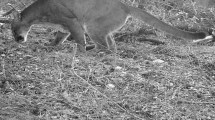Abstract
Communication behaviors play a critical role in both an individual’s fitness as well as the viability of populations. Solitary animals use chemical communication (i.e., scent marking) to locate mates and defend their territory to increase their own fitness. Previous research has suggested that striped skunks (Mephitis mephitis) do not perform scent-marking behaviors, despite being best known for using odor as chemical defense. We used video camera traps to document behaviors exhibited by striped skunks at a remote site in coastal California between January 2012 and April 2015. Our camera traps captured a total of 71 visits by striped skunks, the majority of which (73%) included a striped skunk exhibiting scent-marking behaviors. Overall, we documented 8 different scent-marking behaviors. The most frequent behaviors we documented were cheek rubbing (45.1%), investigating (40.8%), and claw marking (35.2%). The behaviors exhibited for the longest durations on average were grooming (\( \overline{x} \) = 34. 4 s) and investigating (\( \overline{x} \) = 21.2 s). Although previous research suggested that striped skunks do not scent mark, we documented that at least some populations do and our findings suggest that certain sites are used for communication via scent marking. Our study further highlights how camera traps allow researchers to discover previously undocumented animal behaviors.



Similar content being viewed by others
References
Allen ML, Hocevar L, Krofel M (2017a) Where to leave a message? The selection and adaptive significance of scent-marking sites for Eurasian lynx. Behav Ecol Sociobiol 71:136. https://doi.org/10.1007/s00265-017-2366-5
Allen ML, Gunther MS, Wilmers CC (2017b) The scent of your enemy is my friend? The acquisition of large carnivore scent by a smaller carnivore. J Ethol 35:13–19
Allen ML, Yovovich V, Wilmers CC (2016a) Evaluating the responses of a territorial solitary carnivore to potential mates and competitors. Sci Rep 6:27257. https://doi.org/10.1038/srep27257
Allen ML, Wittmer HU, Setiawan E, Jaffe S, Marshall AJ (2016b) Scent marking in Sunda clouded leopards (Neofelis diardi): novel observations close a key gap in understanding felid communication behaviours. Sci Rep 6:35433. https://doi.org/10.1038/srep35433
Allen ML, Wittmer HU, Houghtaling P, Smith JL, Elbroch M, Wilmers CC (2015a) The role of scent marking in mate selection by female pumas (Puma concolor). PLoS One 10:e0139087. https://doi.org/10.1371/journal.pone.0139087
Allen ML, Wallace CF, Wilmers CC (2015b) Patterns in bobcat (Lynx rufus) scent marking and communication behaviors. J Ethol 33:9–14. https://doi.org/10.1007/s10164-014-0418-0
Allen ML, Wittmer HU, Wilmers CC (2014) Puma communication behaviours: understanding functional use and variation among sex and age classes. Behaviour 151:819–840
Bailey T (1974) Social organization in a bobcat population. J Wildl Manag 38(3):435–446. https://doi.org/10.2307/3800874
Baldwin RA (2015) UC IPM pest notes: skunks. UC ANR Publication 74118
Fisher KA, Stankowich T (2018) Antipredator strategies of striped skunks in response to cues of aerial and terrestrial predators. Anim Behav 143:25–34
Gosling L, Roberts S (2001) Scent-marking by male mammals: cheat-proof signals to competitors and mates. Adv Stud Behav :169–217. https://doi.org/10.1016/S0065-3454(01)80007-3
Krofel M, Hocevar L, Allen ML (2017) Does human infrastructure shape scent marking in a solitary felid? Mamm Biol 87:36–39. https://doi.org/10.1016/j.mambio.2017.05.003
Lariviere S, Messier F (1996) Aposematic behaviour in the striped skunk, Mephitis mephitis. Ethology 102:986–992
Lariviere S, Messier F (1998a) Spatial organization of a prairie striped skunk population during the waterfowl nesting season. J Wildl Manag 62:199–204
Lariviere S, Messier F (1998b) Denning ecology of the striped skunk in the Canadian prairies: implications for waterfowl nest predation. J Appl Ecol 35:207–213
Mellen JD (1993) A comparative analysis of scent-marking, social and reproductive behavior in 20 species of small cats (Felis). Am Zool 33:151–166. https://doi.org/10.1093/icb/33.2.151
Nams VO (1991) Olfactory search images in striped skunks. Behaviour 119:267–284. https://doi.org/10.1163/156853991X00472
Ralls K (1971) Mammalian scent marking. Science 171:443–449. https://doi.org/10.1126/science.171.3970.443
R Core Team (2016) R: a language and environment for statistical computing. R Foundation for Statistical Computing, Vienna
Russell AF, Brotherton PNM, McIlrath GM, Sharpe LL, Clutton-Brock TH (2003) Breeding success in cooperative meerkats: effects of helper number and maternal state. Behav Ecol 14:486–492. https://doi.org/10.1093/beheco/arg022
Smith JLD, McDougal C, Miquelle D (1989) Scent marking in free-ranging tigers, Panthera tigris. Anim Behav 37:1–10. https://doi.org/10.1016/0003-3472(89)90001-8
Sokal RR, Rohlf FJ (2012) Biometry. The principles and practice of statistics in biological research, 4th edn. W.H. Freeman and Company, New York, NY
Steiger S, Schmitt T, Martin Schaefer HM (2011) The origin and dynamic evolution of chemical information transfer. Proc R Soc B 287:970–979. https://doi.org/10.1098/rspb.2010.2285
Taylor AP, Allen ML, Gunther MS (2015) Black bear marking behaviour at rub trees during the breeding season in northern California. Behaviour 152:1097–1111. https://doi.org/10.1163/1568539X-00003270
Verts B (1967) The biology of the striped skunk. University of Illinois Press, Urbana
Vogt K, Zimmermann F, Kölliker M, Breitenmoser U (2014) Scent-marking behaviour and social dynamics in a wild population of Eurasian lynx Lynx lynx. Behav Process 106:98–106. https://doi.org/10.1016/j.beproc.2014.04.017
Wang Y, Allen ML, Wilmers CC (2015) Mesopredator spatial and temporal responses to large predators and human development in the Santa Cruz Mountains of California. Biol Conserv 190:23–33
Wooldridge RL, Foster RJ, Harmsen BJ (2019) The functional role of scent marking in the social organization of large sympatric neotropical felids. J Mammal 100:445–453. https://doi.org/10.1177/1940082920910364
Acknowledgements
We thank P. Houghtaling, Y. Shakeri, and numerous technicians and volunteers for their help on the project.
Funding
Funding was provided by NSF Grants 0963022 and 1255913, the Gordon and Betty Moore Foundation, the University of California at Santa Cruz, the Illinois Natural History Survey, and the University of Illinois Champaign-Urbana.
Author information
Authors and Affiliations
Corresponding author
Additional information
Communicated by: Thales Renato Ochotorena de Freitas
Publisher’s note
Springer Nature remains neutral with regard to jurisdictional claims in published maps and institutional affiliations.
Rights and permissions
About this article
Cite this article
Jackson, K., Wilmers, C.C., Wittmer, H.U. et al. First documentation of scent-marking behaviors in striped skunks (Mephitis mephitis). Mamm Res 66, 399–404 (2021). https://doi.org/10.1007/s13364-021-00565-8
Received:
Accepted:
Published:
Issue Date:
DOI: https://doi.org/10.1007/s13364-021-00565-8




